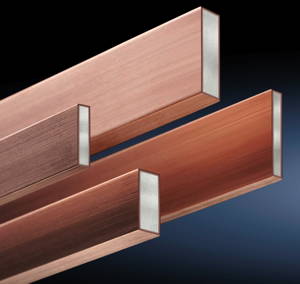It says that the Cuponal copper-coated aluminium busbars are about 30–35% cheaper than solid copper busbars of a similar cross-section, and half the weight. The main limitation is that the composite busbars have maximum current ratings that are 12–14% lower than those of copper.

Copper is usually the material of choice when large currents need to be carried. Its electrical conductivity is almost as good as that of silver, and far higher than those of all other metals. But, in recent years, the price of copper has risen sharply and it is now a significant cost in low-voltage switchgear.
Rittal has therefore been looking for alternative busbar materials for its Ri4Power LV switchgear system. It sees Cuponal is being one of the most promising alternatives. It consists of a composite material with a copper-coated aluminium core.
The busbar exploits the “skin effect” – the phenomenon whereby an alternating magnetic field induced in a conductor displaces the current from the centre, so that it flows along the surface. Although this effect is particularly powerful at high frequencies, it is noticeable even at 50Hz. The design of the Cuponal busbars ensures that most of the current flows through the sections consisting of copper. In the aluminium inner core, with its lower conductivity, the current density is lower.
The new busbar offers similar heat dissipation properties to those of copper bars. All of the components of Rittal`s RiLine60 system can be used unaltered with the Cuponal bars.
Although the new busbars are more complex to produce, they are about 30–35% cheaper than copper bars of a similar cross-section, depending on the prevailing price of copper. The maximum current that the busbar can carry is about 12–14% smaller.
The fact that the Cuponal busbars weigh around half as much as copper bars of a similar size, makes them easier to transport and assemble. The new bars are available in cross-sections from 5 x 20mm (which can carry up to 235A) up to 10 x 30mm (493A).
